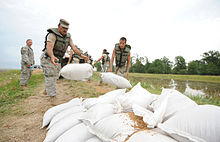Charging
A Aufkadung (from the Low German word "Kade" for the dam, dike) is a temporary increase in a dike or a flood dam in danger of overtopping by an unexpectedly large flood . It is used for flood protection .
The embankment or dyke is quickly reinforced with sandbags , plank walls, mobile elements or boulders brought in by excavators. If the water overflowed, the dam or dyke would break and be washed away. The necessary height must be reached over the entire section of the dike, as the water overflows at the lowest point.
Sandbags
The easiest way to top up is to use sandbags. They have to be filled, transported and laid. Appropriately, the sandbags are only two-thirds filled and not tied, but only turned over and laid with the opening on the water side on the water-side edge of the dam crest. The sandbags can be laid in one or more layers on top of and next to each other. The joints are then staggered as with masonry. Heights of several decimeters can be achieved in this way.
Another option is a box-shaped, double-row structure made of boards and stakes, between which earth, straw and other material is filled.
Lueger 1904
The dictionary of technology (1904) by Otto Lueger defines a Aufkadung than the temporary increase of the dike cap with increasing water (especially in Eisstopfungen). It is done with building materials that are immediately to hand or can be easily procured; rarely through the ground alone, mostly through boards in connection with earth, dung or sandbags. The boards, which are used in one or two rows and are provided with an external or intermediate seal, are fastened by means of opposing posts connected with connective tissue at a distance of about 1.5 m. - Instead of boards, fascines in bunches or in the form of twisted sausages are also used, which are also fastened by driven, but inclined posts and sealed by the ground. The height of the charging is usually 0.3–0.5 m, rarely more than 1 m, and the distance between the two rows of boards is usually 0.6 m. If the dike cap is frozen, stones of the appropriate weight can be used instead of the piles, which are then difficult to drive. in this case the seal is preferably made by means of fertilizer.
Web links
- Lueger 1904: Charging
- Photo of a charging on a dike (page 2) ( Memento from October 11, 2010 in the Internet Archive ) (PDF 1089 kB)
- THW - Charging - Sandbag Dam
- Universal Lexicon: Charging

